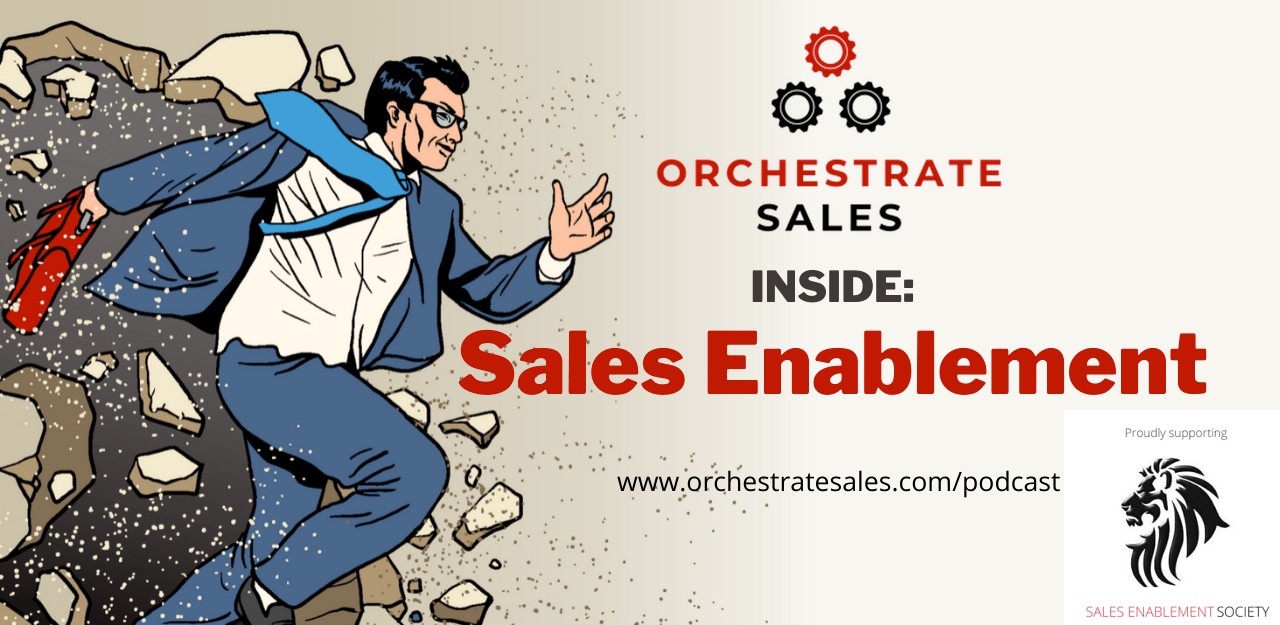Ep14 Improve Sales Coaching Adoption & Joe Gibbs
Welcome to the Inside Sales Enablement Podcast, Episode #14
One of our listeners, Rachel, shared her companies view about sales management and the difficulty managers have in transitioning from being a top-performing rep to sales management.
Sales managers have to live in two worlds, traditional "management skills" and also sales productivity contribution. Sales Enablement leaders looking to implement sales coaching need to be clear about their focus and intent. What can sales enablement leaders do to add value?
Joe Gibbs won Super Bowls 3 different quarterbacks. How? He coached to a system, encouraging people to be themselves, and focusing on outcomes.
There are a lot of people talking about front-line sales managers and having them "go coach more." As much as that's been discussed, sales coaching hasn't really taken off.
The guys talk about:
- What is sales coaching - the difference between sales coaching activities and sales coaching programs
- Unleashing the value of coaching, by embracing the sales leadership perspective
- What are the attributes of successful coaching programs?
Join us at https://www.OrchestrateSales.com/podcast/ to collaborate with peers, join Insider Nation, participate in the conversation and be part of the continued elevation of the profession.
EPISODE TRANSCRIPT:
Scott Santucci 00:01
Hi, team, this is a What is that? So, what is a What is what is that? So, what I'm trying to do is create some structure and curiosity around some servers, certain things and some concepts and explain them and help make them relatable, explain why and whatnot and provide some texture around what's going on, what are some of the things we've got? They are super simple. The difficulty is there's a learning curve to get to simple, and then a comfort factor about applying. And a lot of this has to do with ambiguity, and why we need to produce lots of things to make things accessible. So, I'm trying to what is that? What do you think about what is that? Is that the right title? What should I call this series? You tell me because this is for you, you got to give me feedback. Okay, so one of the things that I think we all understand and can appreciate is that there are many silos involved inside of business. And they create lots of friction, which cancel each other out. And there is a need for Orchestration. I'm hopeful that casting you guys and in specific roles, what's fascinating is behaving in silos instead of operating and roles. What is that? What that is, is a massive amount of muscle memory that we have to create tools out visualize, that holds us in silos, we are prisoners of silos. And we think that we think we say, examples or symptoms of thinking in a silo. I don't know what marketing's doing. You don't need to know what marketing is doing if you're doing your role in our operating model. Or if you need to know column but ask them. There's nothing preventing anybody from doing that. Other examples of being in silos, I mean topics, you can generate your own topics, you you have your own, your job is to figure out how to make your role or the span of things that you can contribute to fit. And what we're all experiencing is this, either a lack of an operating model, or let you know, lack of clarity. And what we need to be able to recognize is all these things are VOCA related. We were clearly not prepared for the speed of V. We continue to use words like business outcomes, yet we haven't defined what makes business language versus nonbusiness language. So, we haven't made that tangible for other people. So, we're going to continue to struggle in uncertainty. So, we have uncertainty. Complexity is what's interesting is what makes something simple for one person is complex for something else. It feels complex learning something simple. So, there's a lot of paradox. If you look at the if you study complex systems theory, one of the things that is associated with complexity is paradoxes. Don't assume things are conflicting. Question it because it's probably complexity. And then finally, of course, ambiguity. Why do we have to have lots of slides because ambiguity is the thing that people hate the most, particularly in business, they can't stand it, they can accept the speed. People have recognized the complexity, that's something that people have tools over. It's the total fuzziness, and fog of ambiguity. And unfortunately, ambiguity is why there are so many friction points on the left. And, you know, the only way to overcome ambiguity is to create things to make things less and less foggy and to have patience as as we bring it along. But that's ultimately a key element of Orchestration. Now, one of the things around Orchestration is that Orchestration to Orchestrate across many departments requires an operating model. So not only do you need to be able to orchestrate yourself, but you have to orchestrate orchestrators. So, each of the different cogs have to be orchestration engines and upon themselves that have to tie together to overall orchestration. That's the role of being a catalyst. And that means there are rules that the other cogs have to follow. When those cogs don't follow those rules, they spin off out of control. Now, some of the cogs want to know how they fit into everything else. And what happens is too much time gets spent talking about the operating model and the philosophy of things and not doing so there's this balancing act that we need to learn how to establish and that clients are going to need you'd have to just establish the phenomenon that we are experiencing happens inside our clients. There is a reason we're organized. I'm going to repeat this. Stay in your roles and question your roles and why you're organized. Don't try to keep coming up with reasons to not be in your roles. The reason why is we have to simulate our clients’ experiences, it's the experience stupid to be able to appreciate what an operating model is. So, we can at least have the bedside manner to talk them through it. While we create the space to create the actual physical artifacts, we can't say things like muscle memory, that's not a tangible, concrete thing. And just because we've all experienced, and we use words, that means stuff to us, they don't have meaning to other people. So here are some examples of operating models. This is from IBM. I'm not going to talk to it. I'm just going to make observations. Here's one around the it operating model. Hint, notice the word capabilities over here, capability service, rigid service management on activities across functions. What its capabilities mean, here. Over here, let's zoom in on here. This is from Bain McKinsey. Look, what they're saying is the operating model is the gap between strategy and execution. Hopefully, you have seen often that we've talked about the blend between strategy and execution, what is the organizational thing that makes it happen? It's an operating model. But operating models are too new for people, or too conceptual, too theoretical, they're architecture driven. So, I've learned that particularly in the sales and marketing space, where the muscle memory that we have, there is too much activity. So, we have the balancing act, right? It seems contradictory. On the one hand, we're not doing enough, but yet we're criticizing people for doing activity without thinking. But we're thinking too much that we've got analysis, paralysis and not producing, then when we produce, it's not the right thing. So, all these different seemingly conflicting variables are experienced, even when you go try to introduce an operating model. Operating models are the key to success for any digital transformation, because what operating models do is cut between strategy and execution. And one of the things that we're going to talk about is, operating models have had their heyday in shared services organizations that are very functional, oriented, like legal, but they are introducing them breaks down because you don't have the vocabulary of only legal or the vocabulary of only human resources. What you're doing is you're cross pollinating across the vocabulary between sales, marketing, human resources, finance, and this English-to-English translation problem kicks in that English-to-English translation problem is huge, and colossally huge, and we need to do a whole lot more work of written bringing it to fruition and making it concrete. Now, that's not the purpose of this video, it's just sort of set up things, criteria for success, if you will.
Scott Santucci 08:14
But what is a business within a business? Why did I share all those other things? What I've learned is the easiest way to get people to think about a business within a business is to get them to think about their their function, as a company within a company, and what company are you? We use that metaphor in the, in the research, we have a lot of material to make this really, really concrete, I mean a ton of material, all we need to do is force ourselves to apply it, all that material and make it more concrete and connect the dots with what we're actually experiencing ourselves. What are we experiencing ourselves? It requires a lot of discipline just to stay super focused and say so what are we? What kind of entity is a sales enablement function? What kind of entity? What kind of service are we providing is growth enablement? What kind of slide am I producing? What is my role? How do I add value? The basic questions have to get answered. And that clarity allows you to operate. So, the business within a business construct is very simple. It's been developed over years and years and years. And it's very simple, but it's basically saying, who are your investors? Just like any other business, a business has investors, right? Then a company has its infrastructure. So, if your ups part of your infrastructure, your trucks, your fleets, the computing infrastructure, the buildings, physical infrastructure, all of that is infrastructure. And then in between, they have business processes a business has processes, where they convert inputs into outputs. And in between is where value is created. That's where value is created. That is how it works at its most simplistic way. So, the, the arrow represents a business process, which you can define at any altitude level that you want the conversion of inputs to outputs this conversion process. The more you do this, the more valuable you are. And it rests on top of infrastructure of which investors are paying for. So, investors are paying for this infrastructure. And what they really want are people who convert inputs to outputs valuable and add value. Okay, so now let's frame this out through the lens of Jen. So, Jen, is trying to figure out how she's adding value we can comment with, with subjectivity that she's adding value, but we don't have any objective measures to communicate if she's adding value or not. And that creates ambiguity. And any kind of ambiguity creates anxiety. What we have to do is police that place that out, so the way that we help that we're helping guide her on the organizational part. The other thing that she's got is I've got she's got a lot of people working for her, how are they contributing value? I hopefully, hopefully we all are experiencing probably the same dilemma, at least can experience on the on the hand of her own team. What how do we contribute? Everybody wants to add value. But do we know how all the piece parts fit together? Are we just blurting in and not understanding the situation, what the operating model or the business within a business construct does is allows us to lay out all the variables to start thinking through how the dots get connected? And in any business, that process there's going to be that group that converts the supply? You know, the suppliers are the input sources of input in a business. So, the suppliers have a manufacturing process might be the chemicals and all that other stuff, how it gets mixed together into something valuable, like maybe, maybe paint, and then it gets out to customers, it gets distributed customers. So, these that those are all clear processes in the digital world, what this process looks like we need to map out, it just isn't mapped out in a knowledge worker way. But we have the ability to say, Okay, let's put a box. And every one of these boxes represents a scope. And so, for Jen to continue to add value. So that's, that's her right here. She's gonna need investors, she gets funding from something, there is an expectation associated with the money that she gets, we're giving you money to do what in return, we get what.
Scott Santucci 13:07
So, think about the value proposition that we're trying to work on. Hi, I'm Jan, I want you to give me more money, that's investors. In return, I'm going to give you less stuff, you're not paying for a whole bunch of punchless things. As a result, you get better return. That's a really hard business proposition. Where inside the world, have you experienced somebody selling you that? Wherever you bought that before? So, it's hard to empathize. It's easy to conceptualize. It's hard to empathize. And this is why we have to do a lot better job of making things tangible. And the way we make things tangible is through slides, but the slides must be situationally aware, which means empathetic, we have to walk in the shoes. In your case, you need to walk in the shoes of me. Are you asking questions about what I'm experiencing? Your client isn't Jen, I am your client. Look how hard it is to get your head around anybody's head around who customers are. I'm going to flesh this out more. And there are many podcasts that we've got Brian and I have done to help flesh this out. But here's, here's the scope. Okay, so this is Jen in the middle. She's got her enablement operations team, we have to figure out what needs to go in scope to be able to deliver the most value. So, like any business, what what's the first thing you think about as any business while the business is what services that you offer? So, what services does Jen offer? Well, before we start thinking about the services, we could say, well, she does kickoff that's an activity. She has sales training. Is that a service? Is sales training a service, or is it an activity? How wired are people to just doing activities? And how immediately do we want to blurt that out? So, if we want to, if we want to go through the service part, like any business, you want to be able to establish the expectations with your investors. And the most basic form that businesses do is step number one, they write a mission and charter statement, you know, why do you exist? You need to write that out and flesh that out in order to get investors. Right. So, what does that look like? Well, then the next thing is you need to establish an executive committee, or a board of directors or some group of people in Jen's case, so the mission and charter statement is something that we need to work on, and we're going to fine tune. But she but it's pretty easy to identify who's paying, what budgets are, who are paying for her services. So, what that does is allows her to start connecting the dots between services versus expectations of people who aren't paying for something. This gets it this kind of decision making or discipline, as a word, again, helps create the foundation so that she can push back, it provides the foundation. So, who where are all of the sources of money? And then maybe there's other departments that she wants to include that she can stitch together to provide other services? Well, who would be those wallet owners? And how do you make the argument to move some budget resources to your budget resources? Okay, so then what you would need to be able to do is say, Okay, well, the quid pro quo, if this is the budget that I've got, and this is the things that I want to do, and these are the people involved, how will you evaluate my success? What does success look like? What are my success indicators? Are they measurable or not? Are they subjective? Or not? How do you create that kind of construct? So as a frame of reference, the value equation is a success indicator of a valuable conversation. In other words, a service that a customer that a salesperson gives to a customer, okay, now, given that, given that basic, hopefully, these these building blocks are in place, and by the way, hopefully, you guys are following here, there's a ton of detail on each one, and we establish or build up the details from there. Okay, so then what you would need to do is, if you want to run this overall department of services with success indicators, mission charter, you're gonna have to have a vision of what you're doing. And this is a big gap that a lot of people have coming up with a vision. So, for example, if you are an architect, what's your vision of how what services you're providing? To me, your executive committee of one, your suppliers would be detangler, clarity, etc. Every what success indicators have you co created to create? Alright.
Scott Santucci 18:16
So, these are the this is sort of structure. And this is where things start, you get to start really thinking and being thoughtful, how am I going to connect the dots? What is my responsibility? What is my accountability? accountability is a huge factor in making an operating model work. And in businesses where we're so associated with my value is on what I produce, rather than my value is what I enable, then it gets it gets really fuzzy. This is why it's incredibly important to have a consistent cadence, about establishing what your success indicators are. and managing expectations, talking through expectations. The only way that you're going to do it is just talking it through. So that's why you create a a feedback loop based on these indicators. Okay, now, it's likely that you're not going to have a one services company, you're going to have to have a portfolio. So, we have a portfolio of services that we offer, we offer clarity services, detangling, services, architect services, capability, services, concept or services. So, we're, my ability to manage the expectations of the whole part, if I'm Gen is dictated by the service portfolio and the vision that my of how well people are orchestrating in those in those groups. We have to be able to empathize with that, because we're going to have to be able to guide you through that because for Jen to be able to execute on some of the things that we're doing. She's gonna have to do this too. So, this is why things become self fulfilling prophecies if we don't produce them. We don't, aren't able to capitalize on the opportunities, we don't have to solve the problems, we just have to make slides and make things more and more clear. And make sure that what we're doing is we're interacting and engaging, engaging, engaging, engaging, not just doing and assuming. So, these are all things that are common challenges associated with an operating model. But using a business within a business model helps illuminate this stuff and gives guidance of what we should be doing. And what should be expected of somebody who's running a service portfolio, for example, okay. I did this wrong. Shoot, I did this in order, or so. Here's the service portfolio. The next thing that you're going to need to be able to do, or Jen's gonna need to do is, how does she steward How is she a good steward of her company's...




